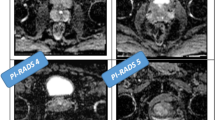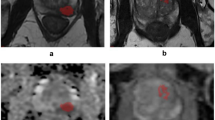Abstract
Aim
Prostate cancer represents the most common cancer afflicting men. It may be asymptomatic at the early stage. In this paper, we propose a methodology aimed to detect the prostate cancer grade by computing non-invasive shape-based radiomic features directly from magnetic resonance images.
Materials and methods
We use a freely available dataset composed by coronal magnetic resonance images belonging to 112 patients. We represent magnetic resonance slices in terms of formal model, and we exploit model checking to check whether a set of properties (formulated with the support of pathologists and radiologists) is verified on the formal model. Each property is related to a different cancer grade with the aim to cover all the cancer grade groups.
Results
An average specificity equal to 0.97 and an average sensitivity equal to 1 have been obtained with our methodology.
Conclusion
The experimental analysis demonstrates the effectiveness of radiomics and formal verification for Gleason grade group detection from magnetic resonance.



Similar content being viewed by others
References
Abele T, Besachio D, Quigley E, Gurgel R, Shelton C, Harnsberger H, Wiggins R (2014) Diagnostic accuracy of screening MR imaging using unenhanced axial ciss and coronal t2wi for detection of small internal auditory canal lesions. Am J Neuroradiol 35(12):2366–2370
Brunese L, Mercaldo F, Reginelli A, Santone A (2019a) An ensemble learning approach for brain cancer detection exploiting radiomic features. Comput Methods Programs Biomed 185:105134
Brunese L, Mercaldo F, Reginelli A, Santone A (2019b) Formal methods for prostate cancer gleason score and treatment prediction using radiomic biomarkers. Magn Reson Imaging 66:165
Brunese L, Mercaldo F, Reginelli A, Santone A (2019c) Neural networks for lung cancer detection through radiomic features. In: 2019 international joint conference on neural networks (IJCNN), IEEE, pp 1–10
Brunese L, Mercaldo F, Reginelli A, Santone A (2019d) Prostate gleason score detection and cancer treatment through real-time formal verification. IEEE Access 7:186236–186246
Brunese L, Mercaldo F, Reginelli A, Santone A (2019e) Radiomic features for medical images tamper detection by equivalence checking. Procedia Comput Sci 159:1795–1802
Brunese L, Mercaldo F, Reginelli A, Santone A (2020) Explainable deep learning for pulmonary disease and coronavirus covid-19 detection from x-rays. Comput Methods Programs Biomed 196:105608
Cameron A, Khalvati F, Haider MA, Wong A (2015) Maps: a quantitative radiomics approach for prostate cancer detection. IEEE Trans Biomed Eng 63(6):1145–1156
Cao R, Bajgiran AM, Mirak SA, Shakeri S, Zhong X, Enzmann D, Raman S, Sung K (2019) Joint prostate cancer detection and gleason score prediction in mp-MRI via focalnet. IEEE Trans Med Imaging 38:2496
Ceccarelli M, Cerulo L, Santone A (2014) De novo reconstruction of gene regulatory networks from time series data, an approach based on formal methods. Methods 69(3):298–305
Chaddad A, Kucharczyk M, Niazi T (2018) Multimodal radiomic features for the predicting gleason score of prostate cancer. Cancers 10(8):249
Cimino MG, De Francesco N, Mercaldo F, Santone A, Vaglini G (2020) Model checking for malicious family detection and phylogenetic analysis in mobile environment. Comput Secur 90:101691
Dougherty J, Kohavi R, Sahami M (1995) Supervised and unsupervised discretization of continuous features. In: Machine learning proceedings 1995, Elsevier, pp 194–202
Doyle S, Madabhushi A, Feldman M, Tomaszeweski J (2006) A boosting cascade for automated detection of prostate cancer from digitized histology. In: International conference on medical image computing and computer-assisted intervention, Springer, pp 504–511
Fernandez J-C, Garavel H, Kerbrat A, Mounier L, Mateescu R, Sighireanu M (1996) CADP a protocol validation and verification toolbox. In: International conference on computer aided verification, Springer, pp 437–440
Francesco Nd, Lettieri G, Santone A, Vaglini G (2014) Grease: a tool for efficient nonequivalence checking. ACM Trans Softw Eng Methodol 23(3):24
Francesco ND, Santone A, Vaglini G (2007) A user-friendly interface to specify temporal properties of concurrent systems. Inf Sci 177(1):299–311
Gardin I, Grégoire V, Gibon D, Kirisli H, Pasquier D, Thariat J, Vera P (2019) Radiomics: principles and radiotherapy applications. Crit Rev Oncol Hematol 138:44
Huang F, Ing N, Eric M, Salemi H, Lewis M, Garraway I, Gertych A, Knudsen B (2018) Abstract b094: quantitative digital image analysis and machine learning for staging of prostate cancer at diagnosis. Cancer Res 78:B094
Hussain L, Ahmed A, Saeed S, Rathore S, Awan IA, Shah SA, Majid A, Idris A, Awan AA (2018) Prostate cancer detection using machine learning techniques by employing combination of features extracting strategies. Cancer Biomark 21:1–21 (Preprint)
Ito Y, Udo K, Vertosick EA, Sjoberg DD, Vickers AJ, Al-Ahmadie HA, Chen Y-B, Gopalan A, Sirintrapun SJ, Tickoo SK et al (2019) Clinical usefulness of prostate and tumor volume related parameters following radical prostatectomy for localized prostate cancer. J Urol 201(3):535–540
Langerak R (1994) Transformations and semantics for LOTOS
Lecouvet F (2016) Whole-body MR imaging: musculoskeletal applications. Radiology 279(2):345–365
Li R, Xing L, Napel S, Rubin DL (2019) Radiomics and radiogenomics: technical basis and clinical applications. Chapman and Hall/CRC, Boca Raton
Litjens G, Debats O, Barentsz J, Karssemeijer N, Huisman H (2014) Computer-aided detection of prostate cancer in MRI. IEEE Trans Med Imaging 33(5):1083–1092
Marshall CH, Fu W, Wang H, Baras AS, Lotan TL, Antonarakis ES (2019) Prevalence of dna repair gene mutations in localized prostate cancer according to clinical and pathologic features: association of gleason score and tumor stage. Prostate Cancer Prostatic Dis 22(1):59
Mercaldo F, Martinelli F, Santone A (2019) Real-time scada attack detection by means of formal methods. In: 2019 IEEE 28th international conference on enabling technologies: infrastructure for collaborative enterprises (WETICE), pp 231–236
Milner R (1989) Communication and concurrency. PHI Series in computer science. Prentice Hall, Upper Saddle River
Nguyen T.H, Sridharan S, Marcias V, Balla AK, Do MN, Popescu G (2016) Automatic gleason grading of prostate cancer using slim and machine learning. In: Quantitative phase imaging II, International Society for Optics and Photonics, vol 9718, p 97180Y
Parnas DL (2017) The real risks of artificial intelligence. Commun ACM 60(10):27–31
Sobecki P, Gora A, Zycka-Malesa D, Sklinda K, Mykhalevych I, Przelaskowski A (2017) Feature extraction optimized for prostate lesion classification. vol Part F128534, pp 22–27
Stirling C (1989) An introduction to modal and temporal logics for CCS. Concurrency: theory language and architecture. Springer, Berlin, pp 2–20
Trebeschi S, Drago S, Birkbak N, Kurilova I, Clin A, Pizzi AD, Lalezari F, Lambregts D, Rohaan M, Parmar C et al (2019) Predicting response to cancer immunotherapy using non-invasive radiomic biomarkers. Ann Oncol 30:998
Van Griethuysen JJ, Fedorov A, Parmar C, Hosny A, Aucoin N, Narayan V, Beets-Tan RG, Fillion-Robin J-C, Pieper S, Aerts HJ (2017) Computational radiomics system to decode the radiographic phenotype. Cancer Res 77(21):e104–e107
Vos PC, Hambrock T, Barenstz JO, Huisman HJ (2010) Computer-assisted analysis of peripheral zone prostate lesions using t2-weighted and dynamic contrast enhanced t1-weighted MRI. Phys Med Biol 55(6):1719
Author information
Authors and Affiliations
Corresponding author
Ethics declarations
Conflict of interest
All authors confirm that there are not potential conflicts of interest include employment, consultancies, stock ownership, honoraria, paid expert testimony, patent applications/registrations and grants or other funding. Ethics committee/IRB was obtained and patient informed consent was obtained.
Ethical standards
This article does not contain any studies with human participants or animals performed by any of the authors.
Additional information
Publisher's Note
Springer Nature remains neutral with regard to jurisdictional claims in published maps and institutional affiliations.
Rights and permissions
About this article
Cite this article
Santone, A., Brunese, M.C., Donnarumma, F. et al. Radiomic features for prostate cancer grade detection through formal verification. Radiol med 126, 688–697 (2021). https://doi.org/10.1007/s11547-020-01314-8
Received:
Accepted:
Published:
Issue Date:
DOI: https://doi.org/10.1007/s11547-020-01314-8




